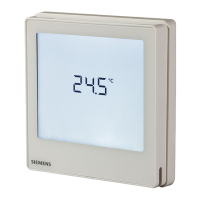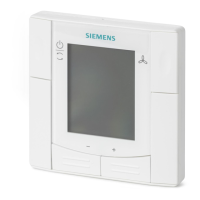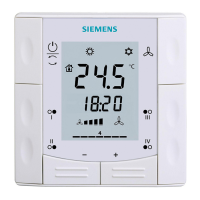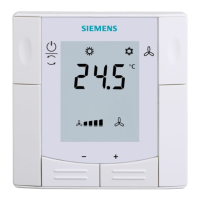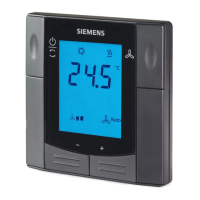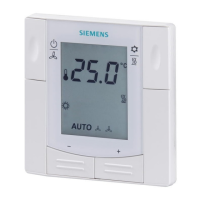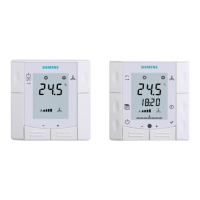62 / 94
Siemens RDF800KN.., RDF800KN/VB, RDD810KN/NF Basic documentation CE1P3174en
Smart Infrastructure 2020-02-21
Obj Object name Function Type/length Flags
27 Cooling output
primary
0…100% 5.001
8 bit
CRT
Indicates the position of the cooling actuator of the first stage.
E.g. 2-pipe with electric heater application: Output of cooling coil
29 Enable electric
heating
Enable/
Disable
1.003
1 bit
CWU
An electric heater can be disabled with this communication object
(e.g. to meet tariff regulations).
The same function is also available using local multifunctional
input X1/X2 (P38 or P40).
Only one input source must be used, either local input X1/X2 or
the KNX bus.
30 Heating/cooling
changeover
Heat/
Cool
1.100
1 bit
CWU
Changeover information transmitted by bus.
Default: Current mode before power down.
The same function is also available using local multifunctional
input X1/X2 (P38 or P40).
Only one input source must be used, either local input X1/X2 or
KNX bus..
31 Application mode HVAC
control
mode
20.105
8 bit
CWU
0 Auto (default) Heating and/or cooling
1 Heat Heating only
2 Morning warmup* Heating only
3 Cool Cooling only
5 Precool* Cooling only
6 OFF Neither heating nor cooling
8 Emergency heat* Heating only
9 Fan only Fan runs at high speed
* Function handled like Heat (1) or Cool (3)
32 Enable fan
command value
Enable
Disable
1.003
1 bit
CWU
Set fan mode to Auto (disable) or Manual (enable) using a KNX
control unit. If Manual, the value received on Fan command value
(34) will be used to command the fan speed.
Default: Enable
The last selected option is implemented – either from the local fan
icon or using bus.
33 Fan operation Auto
Manual
1.001
1 bit
CRT
Indicates the state of the fan mode: Auto (0) or Manual (1).
34 Fan command
value
0…100% 5.001
8 bit
CWU
The fan can be set to a specified speed by a KNX control unit
when manual fan operation is enabled.
Speed Fan command value (physical KNX value)
1 1...33% (1…85)
2 34…67% (86...170)
3 68…100% (171…255)
Fan speed "0" is not supported by the thermostat and the fan
speed will remain unchanged.
35 Fan output 0…100% 5.001
8 bit
CRT
Indicates the current fan speed as a value 0...100%
Speed Fan output (physical KNX value)
OFF 0% (0)
1 33% (84 )
2 66% (186)
3 100% (255)
36
37
38
Fan speed 1
Fan speed 2
Fan speed 3
ON
OFF
1.001
1 bit
CRT
Indicate the state of the relay outputs
Obj Object name Function Type/length Flags
39
40
X1: Temperature
X2: Temperature
Temp.
value
9.001
2 Byte
CRT
Indicate the values of the temperature sensors connected to the
local inputs X1/X2
41
42
X1: Digital
X2: Digital
ON
OFF
1.001
1 bit
CRT
Indicates the state of the digital inputs (adjusted by P39 or P41)
including consideration of operating action
44 Outdoor
temperature
Temp.
value
9.001
2 Byte
CWU
The outdoor temperature acquired by a KNX sensor can be
displayed on the thermostat, if P07 "Additional user information" is
set = 2 (outdoor temperature).
45 Presence detector
1.019
1 bit
CWU
The thermostat is set to Comfort mode if value "1" (occupied) is
received. It switches back to Economy when the value is "0"
(unoccupied).
"Presence detector" is sent using KNX. It has the same effect as
the “Local presence detector” function on X1/X2 (P38 or P40).
Only one input source must be used, either local input X1/X2 or
the KNX bus.
46 Room
temperature:
Economy heating
setpoint
9.001
2 Bytes
CWU
Communication object to adjust the Economy heating setpoint
used by the thermostat (see section 3.3.2). It changes the value of
P11.
S-mode object must be enabled by setting “Room temp. :
Economy setpoints” to “as group object.
The Economy setpoint is stored in EEPROM. The service life of
the EEPROM depends on the number of write cycles. Never write
this communication object cyclically.
47 Room
temperature:
Economy cooling
setpoint
9.001
2 Bytes
CWU
Communication object to adjust the Economy cooling setpoint
used by the thermostat (see section 3.3.2). It will directly change
the value of P12.
S-mode object must be enabled by setting “Room temp. :
Economy setpoints” to “as group object.
The Economy setpoint is stored in EEPROM. The service life of
the EEPROM depends on the number of write cycles. Never write
this communication object cyclically.
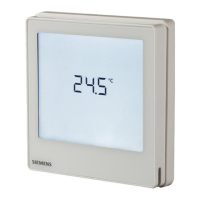
